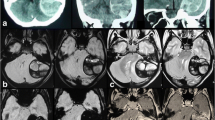Abstract
Background
Dural-based cavernous malformations are rare and have been more commonly described in the middle fossa. Fewer than 20 cases outside of the middle fossa have been reported and they often mimic more commonly found lesions such as meningiomas or hemangiopericytomas.
Case description
We describe the unusual case of a right frontal convexity dural cavernous malformation with intradural and extradural components as well as erosion through the calvarium. The patient underwent a right frontal craniotomy and en-bloc resection of the mass. Final pathologic interpretation confirmed a cavernous malformation that had eroded through the calvarium.
Conclusion
Dural-based cavernous malformations are a rare entity, but should be considered in the differential diagnosis of atypical appearing dural-based lesions and soft subgaleal masses. If atypical features are present, further radiographic investigations should be undertaken. To our knowledge, this is the only reported case of a dural-based cavernous malformation eroding through the calvarium and presenting initially as a soft scalp mass.






Similar content being viewed by others
Abbreviations
- CT:
-
Computed tomography
- MRI:
-
Magnetic resonance imaging
References
Barnett GH, Chou SM, Bay JW, Barnett GH, Chou SM, Bay JW (1986) Posttraumatic intracranial meningioma: a case report and review of the literature. Neurosurgery 18(1):75–78
Bendszus M, Rao G, Burger R, Schaller C, Scheinemann K, Warmuth-Metz M, Hofmann E, Schramm J, Roosen K, Solymosi L (2000) Is there a benefit of preoperative meningioma embolization? [see comment]. Neurosurgery 47(6):1306–1311
Boockvar JA, Stiefel M, Malhotra N, Dolinskas C, Dwyer-Joyce C, LeRoux PD (2005) Dural cavernous angioma of the posterior sagittal sinus: case report. Surgical Neurology 63(2):178–181
Dean BL, Flom RA, Wallace RC, Khayata MH, Obuchowski NA, Hodak JA, Zabramski JM, Spetzler RF (1994) Efficacy of endovascular treatment of meningiomas: evaluation with matched samples. Am J Neuroradiol 15(9):1675–1680
Del CO Jr, Kelly DL Jr, Elster AD, Craven TE (1991) An analysis of the natural history of cavernous angiomas. J Neurosurg 75(5):702–708
Detwiler PW, Porter RW, Zabramski JM, Spetzler RF (1997) De novo formation of a central nervous system cavernous malformation: implications for predicting risk of hemorrhage. Case report and review of the literature.[see comment]. [Review] [29 refs]. J Neurosurg 87(4):629–632
Fehlings MG, Tucker WS (1988) Cavernous hemangioma of Meckel’s cave. Case report. J Neurosurg 68(4):645–647
Gunel M, Awad IA, Anson J, Lifton RP (1995) Mapping a gene causing cerebral cavernous malformation to 7q11.2–q21. Proc Natl Acad Sci U S A 92(14):6620–6624
Gunel M, Awad IA, Finberg K, Anson JA, Steinberg GK, Batjer HH, Kopitnik TA, Morrison L, Giannotta SL, Nelson-Williams C, Lifton RP (1996) A founder mutation as a cause of cerebral cavernous malformation in Hispanic Americans. N Engl J Med 334(15):946–951
Hyodo A, Yanaka K, Higuchi O, Tomono Y, Nose T (2000) Giant interdural cavernous hemangioma at the convexity. Case illustration. . J Neurosurg 92(3):503
Lewis AI, Tew JM Jr, Payner TD, Yeh HS (1994) Dural cavernous angiomas outside the middle cranial fossa: a report of two cases. [Review] [32 refs]. Neurosurgery 35(3):498–504
Macpherson P (1991) The value of pre-operative embolisation of meningioma estimated subjectively and objectively. Neuroradiology 33(4):334–337
Massa-Micon B, Luparello V, Bergui M, Pagni CA (2000) De novo cavernoma case report and review of literature. [Review] [14 refs]. Surg Neurol 53(5):484–487
McCormick WF, Hardman JM, Boulter TR (1968) Vascular malformations (“angiomas”) of the brain, with special reference to those occurring in the posterior fossa. J Neurosurg 28(3):241–251
Phillips LE, Koepsell TD, van Belle G, Kukull WA, Gehrels JA, Longstreth WT Jr (2002) History of head trauma and risk of intracranial meningioma: population-based case-control study. Neurology 58(12):1849–1852
Quattrocchi KB, Kissel P, Ellis WG, Frank EH (1989) Cavernous angioma of the tentorium cerebelli. Case report. J Neurosurg 71(6):935–937
Rigamonti D, Hadley MN, Drayer BP, Johnson PC, Hoenig-Rigamonti K, Knight JT, Spetzler RF (1988) Cerebral cavernous malformations. Incidence and familial occurrence. N Engl J Med 319(6):343–347
Robinson J, Awad I (1993) Clinical spectrum and natural course. In: Awad I, Barrow D (ed) Cavernous malformations. American Association of Neurological Surgeons, Park Ridge, pp 25–36
Sathi S, Folkerth R, Madsen JR (1992) Cavernous angioma of the posterior fossa dura mimicking a meningioma: case report and review of literature. [Review] [15 refs]. Surg Neurol 38(4):257–260
Simard JM, Garcia-Bengochea F, Ballinger WE Jr, Mickle JP, Quisling RG (1986) Cavernous angioma: a review of 126 collected and 12 new clinical cases. Neurosurgery 18(2):162–172
Vogler R, Castillo M (1995) Dural cavernous angioma: MR features. Am J Neuroradiol 16(4):773–775
Zabramski JM, Wascher TM, Spetzler RF, Johnson B, Golfinos J, Drayer BP, Brown B, Rigamonti D, Brown G (1994) The natural history of familial cavernous malformations: results of an ongoing study. J Neurosurg 80(3):422–432
Author information
Authors and Affiliations
Corresponding author
Rights and permissions
About this article
Cite this article
Hwang, S.W., Pfannl, R.M. & Wu, J.K. Convexity dural cavernous malformation with intradural and extradural extension mimicking a meningioma: a case report. Acta Neurochir (Wien) 151, 79–83 (2009). https://doi.org/10.1007/s00701-008-0175-3
Received:
Accepted:
Published:
Issue Date:
DOI: https://doi.org/10.1007/s00701-008-0175-3




